Automatic Weapons, also known as Machine guns, are not just weapons that shoot more bullets than other firearms. While it may be true that ‘throwing’ more bullets at the enemy increases the chance of hitting him in the real world it is not that simple.
For instance, an AK-47 assault rifle, used in many movies has a thirty round clip (usually). The rate of fire is listed at six hundred rounds a minute (cyclic), which means firing continuos without reloading, jams, or problems of any kind. At six hundred rounds a minute that is ten rounds a second, after three seconds of continuos fire you have to reload which can take more than five seconds. At over one pound per magazine of ammo you have to worry about storing it and carrying it. Ammo gets heavy and too much can slow you down. In reality the AK47 fires about ninety rounds a minute (automatic) and forty rounds a minute (semi). This is a respectable rate of fire nevertheless.
A standard combat load for an M16-A2 Assault rifle is seven magazines, that is two hundred ten rounds. An M-249 SAW (Squad Automatic Weapon) usually has around six to eight hundred rounds.
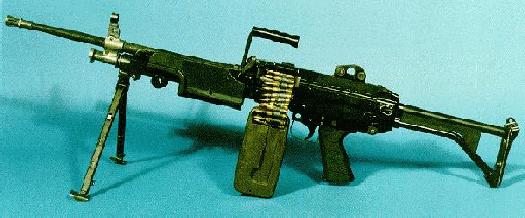
When a weapon fires it generates friction heat, fire too many rounds and the barrel can literally melt. First it will start glowing red, then white. Modern machine guns frequently have interchangeable barrels so if one barrel is getting too hot (or is jammed) it can be quickly replaced with another barrel. In some cases a light machine gun is little more than a regular assault rifle built to take the heat and stress of automatic fire. The Soviet RPK for instance can only fire about eighty rounds a minute if it is to avoid melting.
Firing four hundred rounds, continuos, through a SAW will melt the barrel. Any weapon that is fired too much will get very hot.
Another problem with automatic weapons is their lack of accuracy. Firearms usually have a ‘kick’ when they are fired. This recoil affects accuracy, accuracy is what kills the enemy, not volume of fire or the sound of bullets. A machine gun is inherently inaccurate when fired. The recoil of the first round affects the aiming point of the second round. The more rounds that are fired the more off target the shooter gets. To compensate short controlled bursts are fired instead of long continuos bursts. This allows the gunner to readjust his aim in between bursts and also gives the barrel a chance to cool down, if only for a second or two.
Aiming is just as important for a machine gun as any other weapon. Back to our MP5. If the shooter does NOT aim his bullets will spread out in a shot gun pattern, the more distance the more spread. The farther a bullet travels the more ‘off course’ it gets if improperly aimed. One single bullet does not insure a kill. A forty-four magnum will not automatically kill the target.
Bullets are very small and they go where they are aimed unless they are affected by wind or gravity. At a hundred yards a man sized target is not that big and bullets do not get bigger. The smallest miscalculation in aiming can insure a miss. If the shooter does not aim he will be lucky to score a hit.
One option when using an automatic weapons is to ‘walk your rounds into target’. What this means is that the shooter see’s where his rounds are hitting and adjusts his aim accordingly. This requires a large amount of ammo and can cause weapons to heat up prematurely. This is not a good method for several reasons. One, the enemy may be shooting back and will not give you time to adjust your aim unless he cowering behind cover, in which case you won’t hit him anyway. Two, ammo use is high (which means reloading and during this time the enemy may decide to shoot back). The third reason this is a bad idea is it takes time and tells the enemy where you are at. One of Murphy’s laws of Combat states that “Teamwork is essential, it gives them someone else to shoot at.” If you are concentrating on my buddy you are not concentrating on me and I will ventilate you.
If you have time and ammo, walking the rounds onto target is good. ALL machine guns have sights, even if they are basic ones.
One of the most important aspects of automatic weapons is their intimidation factor. They are scary, even in an amateurs hands. All those bullets slamming into the ground around you can be very frightening. This intimidation factor is one of the main reasons automatic weapons are so popular.
So let’s recap the basics of automatic weapons. Machine guns need lots of ammo. Machine guns overheat and melt if you fire all that ammo. If you do not attempt to aim you are wasting all that ammo. Reloading is a bitch when you are being shot at. Rambo was a stupid movie for these reasons.
Understanding the mechanics let’s look at the tactics used.
![]()
Submachine Guns and Machine Pistols: A cross between a automatic pistol and a carbine, SMG’s have a limited use outside of a small area. The greatest strength of these small machine guns is that they can provide a large volume of close range fire. At longer ranges (over 100meters) they are horribly inaccurate. Machine pistols are even worse. In close range, room to room fighting they are superb. Their small size makes them easier to handle and their firepower makes them downright deadly.
Small Machine guns are plagued with many of the problems of larger machine guns. Ammo consumption, overheating, ect. Most elite units employ SMG’s with different fire rate settings and even then full auto fire is rarely used except to gain fire superiority. Some settings are Single Shot (preferred because it is more accurate and conserves ammo). Double shot fires two bullets with one trigger pull. This inflicts a “Double tap” on the target (see wounds and death). Three round Burst fires three rounds for every trigger pull. This setting is designed to help the shooter gain fire superiority without wasting too much ammo. Other settings like five round burst are possible and are similar to three round burst in purpose. Full Auto is more of a desperation fire mode. Some SMG’s only have single shot and Auto. In a firefight a shooter may select Auto and waste an entire magazine in panic.
SMG’s were born in World War 2 and were initially issued to Nazi NCO’s. The Russians were more liberal with SMG’s and the Nazi’s eventually eased up and issued them to more than NCO’s despite their limited range.
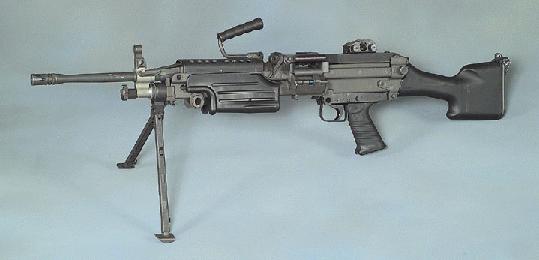
Light Machine Guns: Many people I know would have argued this point. A light machine gun is still a heavy son of a bitch, especially when you take into account the ammo that has to be carried. Light machine guns are designed to be operated by one person in the assault.
LMG’s are some of the fastest firing machine guns. Designed to serve as a squad or fireteam machine gun they have a high rate of fire and have a smaller caliber than other machine guns. The high volume of fire allows a small unit to quickly gain fire superiority by intimidating the enemy. The smaller caliber allows the machine gunner to carry more ammunition and because smaller caliber’s have less recoil, the LMG is more easily controlled than other machine guns. Rambo would have done much better with an LMG.
LMG’s are belt fed or magazine fed. Some, like the M-249 (minimi) can take both (only one at a time though). Soviet LMG’s are usually magazine fed. LMG ammunition is usually compatible with comparable assault rifle ammunition (and can take assault rifle magazines).
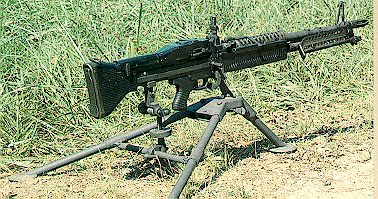
Medium Machine Gun: This is what Rambo likes for no reason I can see. The MMG or as it is frequently called, the GPMG (General Purpose Machine Gun), is usually a higher caliber weapon than a LMG. This means that the GPMG has more recoil (usually much more recoil!) and the bullets have superior penetration than a light machine gun. The sound of a GPMG is also more intimidating than smaller caliber weapons and this may be a reason it is feared more. Also, the heavier caliber round means the range is longer
Because the ammo is heavier and the GPMG is more likely to be fired more, most GPMG’s have a lower rate of fire than a LMG. This means that the barrel does not overheat so quickly and ammo consumption is not so high. Someone has to carry all that ammo.
The recoil discourages gunners from firing from any other position than a braced one. GPMG’s frequently come with tripods and they all come with bipods. The tripod is the best way to fire the GPMG because it is more stable and allows more accurate fire. The bipod is a second best. Firing the GPMG while moving is pure stupidity (like what Rambo was doing) because it is inaccurate and easy to lose control of the weapon. Firing from a standstill is not advised because of the poor accuracy.
It should be noted that in the Rambo movie Sylvester Stallone was firing blanks. Blank ammunition does not have the recoil of real ammunition, just enough to operate the weapon. Had Rambo been firing real ammo he would have shot the ground, the sky, the cameraman and just about everything but the target.
Until the development of light machine guns the GPMG was the standard machinegun. GPMG’s are usually crew served but can be operated by on man. A crew usually consists of a team leader who directs the gun, the gunner who fires it and an assistant gunner who carries the tripod and extra ammo. During firing the assistant will insure the weapon remains loaded. Another rifleman may be assigned to a machine gun team to provide security and carry ammo.
GPMG’s are usually belt fed. Belts can be linked together but it is usually impractical to do this unless the weapon is stationary and will not be moving.

Heavy Machine Guns: These are monsters. The barrel of a US M2 fifty caliber machine gun is over fifty pounds alone. Ammunition is also much heavier and devastating.
These weapons can only be fired from a tripod or mount. In most cases there are two handles behind the weapon for the gunner to grasp. The trigger is a butterfly shaped button in between that is pressed by the thumbs.
Although the rate of fire is much lower these weapons frequently have the penetration and power to go through several men standing behind each other. Some lightly armored vehicles are not immune to these weapons. The sheer kinetic force from these weapons is said to be able to tear a man in two.
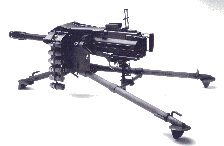
In Vietnam a new type of heavy machine gun was introduced, the automatic grenade launcher. Since its introduction it has become a favorite weapon. The US fields a forty millimeter grenade launcher (which is NOT compatible with the 40mm rifle mounted grenade launcher) and the Soviets have a 30mm automatic grenade launcher (first used in Afghanistan). Automatic grenade launcher ammo is not compatible with hand held grenade launchers because of the charge. HMG barrels are much more heavier and can handle more pressure. A grenade taken from a HMG would explode in a regular hand held grenade launcher (plus the links that are a part of the shell may inhibit loading).
HMG’s are devastating weapons but they are just not as man portable as one would like. HMG’s will usually fire a burst of three to five rounds.
COVERING FIRE: This is when machine guns are most useful. Their high volume of fire and high degree of intimidation is a great way to scare the opposition into taking cover and staying there. In the attack this is incredibly important because it allows other attackers to get into position where they can do the most damage to the enemy. A high number of tracers in the ammo mix can magnify the intimidation of the machine gun but using more tracers should be considered carefully because tracers can be backtracked to their source.
Light Machine guns are likely to travel with the assault group, heavier machine guns are best deployed where they can shoot over the heads of the assault group or from the side where they will not endanger the assault group. Colored smoke or radio is the best method of telling the supporting machine guns to cease fire because they might not be able to tell when friendly forces are too close.
Patrol: On patrol machine guns are best deployed in a location where they are best protected from an enemy. Machine gunners do not walk point for this reason. When the shooting starts Machine guns should be able to deploy to the best position possible instead of being pinned down in the initial volley of enemy fire.
When deployed they should be placed where they can do the most damage to the enemy.
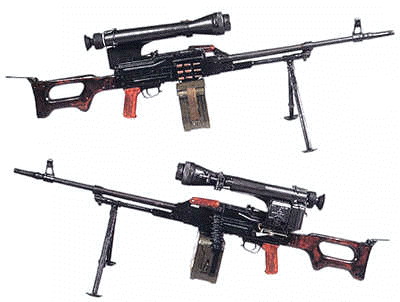
Defense: Machine guns are the backbone of the defense. They can set up a wall of fire that the enemy dare not cross. Two machine guns working together can fire across each others front and creating an X. This ‘X’ is one way of creating a wall of fire and preventing the enemy from over running the defensive position. This is called “Final Protective Fires” and is done only when the signal is given.
When the enemy begins the attack, machine gunners are directed to engage groups of enemy troops. They try to break the enemy’s attack. Machine guns should not be the first weapons to open fire. Riflemen should start firing first. This helps conceal the locations of the machine guns because the enemy may see the initial muzzle flash from a rifleman’s weapon, but by the time the machine guns open up the enemy is (hopefully) busy taking cover and doesn’t have the time to look for the machine guns amid all the other weapons firing at him.
One problem with machine guns in the defense is their vulnerability. As I said earlier machine guns are the backbone of the defense. The enemy would think nothing of using any weapon to take out the machine guns. When the machine guns are destroyed then the organized defense can crumble more easily because it becomes a battle of stationary riflemen against moving machine guns, rocket launchers and riflemen. There is a term for a stationary rifleman – sitting duck.
In the defense machine guns get the best locations, heavy MG’s taking priority over lighter MG’s. Riflemen fill in the gaps between machine guns.
Machine guns are also deployed where they can shoot the farthest and across open ground. This allows the use of “Grazing fire” meaning the bullets travel above the ground between one and four feet high for as far as possible. Grenade launchers are designated to cover those areas a machine gun cannot because they can fire indirectly.
When things become desperate for the defenders the signal is given for “Final Protective Fires” and the machine guns rotate to shoot across the front of friendly forces and create a ‘Wall of fire’. This wall of lead is called a FPL or Final Protective Line and is designated before the fight begins. Stakes may be used to help the machine gunner aim correctly at night or in smoke.
Effects: Machine guns basically do what other bullets do. However, machine guns are more likely to use special rounds such as tracers and armor piercers. Some machine guns can fire more powerful rounds because of the heavier barrels. A US M2 fifty caliber machine gun can fire at ranges over two miles. Heavy machine guns can also be fired single shot if the trigger is pressed quick enough. Carlos Hathcock used a fifty cal MG with a scope mounted on it to kill a VC at close to two miles away. The weapon was fired single shot and was not employed as an automatic weapon.
Night Fire: This is very dangerous for a machine gun. The sound and the muzzle flash are a dead giveaway. Firing ten bullets means creating ten muzzle flashes and a muzzle flash is one of the best ways of locating the enemy. Since most machine guns are not that mobile it means they become a prime target.
Many machine guns are equipped with nightscopes because it gives them a small edge. Currently nightscopes are awkward to mount and the muzzle flash can interfere with them but they are better than nothing.
Manning: Machine guns are always manned meaning there is always someone at the machine gun and ready to use it in a combat zone. If the Machine gunner has to urinate, dig a hole, get out his sleeping bag, ect, the assistant machine gunner gets behind the weapon.
Anti-tank: Believe it or not machine guns are an important part of armor-kill teams. Against a heavily armored tank machine guns are basically useless right? -Wrong!
When a tank crew is buttoned up inside their tank their visibility is severely limited. A tank crew inside their tank cannot see anti-tank missiles or rockets fired until it is too late in most cases. To prevent getting ambushed and to see their surroundings more clearly, tank crews stick their heads or whole bodies up out of the hatch. This allows them to see a missile launched at them and they can take evasive action.
Furthermore, tanks are usually very vulnerable without infantry to protect them, especially in cities or rough terrain.
When an armor-kill team ambushes a group of tanks the machine guns fire first. This encourages the tank crews to button up and hide inside their tanks to avoid getting shot. This is when the missile fires. It takes time for the crew to button up and by the time they are ready to fight back the missile has been launched and is preparing to hit them.
Machine guns also keep infantry away while the tanks are killed. In Chenchenya the defenders of Grozny virtually slaughtered the Soviet aggressors doing this.

Terms
Grazing Fire: an area one to four feet high across an open area. Machine guns are deployed to maximize grazing fire.
Final Protective Fires: A term used to denote when machine guns should resort to their FPL’s. The command to fire FPF’s is usually given when the enemy is about to over run all or part of the perimeter. Machine guns fire as fast as they can in order to create a wall of lead across the unit’s front.
Final Protective Line: a direction for the machine gun to point that allows it to shoot across the unit’s front and interlock with other machine guns. This allows the MG’s to create a “Wall of lead”.
Beaten Zone: This is an area where the bullets from a machine gun land.
Trajectory: This is the path of a bullet. Bullets do not travel in a strait line because of gravity, they travel in an arc. The further the range the steeper the curvature.
Cone of Fire: This incorporates the area between the muzzle and the beaten zone. When a burst is fired they do not all follow the same path, they diverge a little bit to cover more area. Even if the weapon is locked in a certain position, not all the rounds will hit the same point. Atmospheric, recoil and variations in the ammunition create variation.
Plunging Fire: This is defined as an area where it is dangerous for a person to be. Plunging fire is obtained when firing from hill top to hill top, down into an area or up onto a hill. To protect against plunging fire defenders need overhead cover which is not always available.
Traverse and Elevation: Because Medium and heavy machine guns are most effective when fired from a mount (tripod or vehicle) there are certain aspects that affect the accuracy and abilities of the weapon. These larger machine guns have a mechanism located under the gun that fixes it into a certain position. This mechanism called a T & E (Traverse and Elevation) is used to provide fine control over accuracy. The T&E usually has two knobs, one controls horizontal control, the other controls vertical control. This allows the gunner to fine tune his accuracy. Without a T&E any adjustment by the gunner (like to move his elbow to a more comfortable position) can have a massive impact on the accuracy.
By using the T&E a machine gun is a very accurate, very deadly weapon.
Some Terminology
Frontal Fire: This is when the gunner is facing the enemy. This is not what machine gunners like to think about because the enemy is usually shooting back.
Flanking Fire: This is when the gunner is shooting at the side of the enemy. In this case the enemy is not facing (and shooting at?) the gunner.
Oblique Fire: This is when the gunner is shooting at an angle relevant to the long axis of the target.
Enfilade Fire: This is what machine gunners have wet dreams about. The long axis of the enemy is lined up for the gunner so that in theory, one bullet could kill them all. The enemy may be facing the gunner (Frontal Enfilade Fire) or facing away from the gunner (Flanking Enfilade Fire).
Machine Gun Squads
In some cases two or more teams of machine guns (a Machine Gun Squad usually has two) may be deployed as a squad. This can get messy for the enemy because of the concentrated firepower. In many cases machine gun teams are deployed separately but sometimes machine gun teams are deployed as a squad.
In garrison machine gun squads usually live and train together and are assigned to the Weapons platoon. When the unit goes to the field they are deployed as the company commander sees fit. By billeting the machine gunners together it helps standardize training and logistics in garrison.



